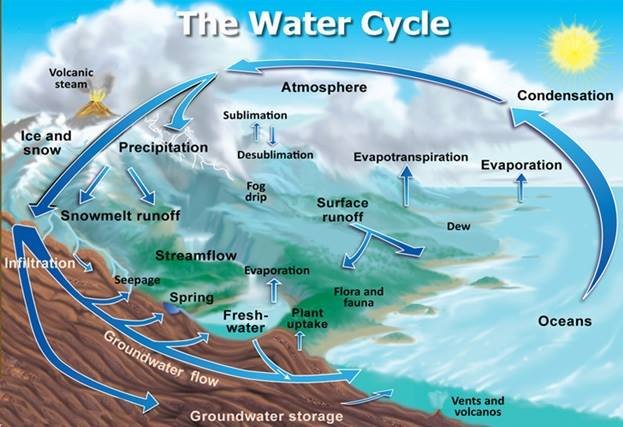)
Image Source
The water cycle (also known as the hydrological cycle or the hydrologic cycle) - describes the continuous movement of water on, above and below the surface of planet Earth.
The mass of water on Earth remains fairly constant over time, but the partitioning of the water into the major reservoirs of ice, fresh water, saline water (or salt water), and atmospheric water (or air moisture) - is variable depending on a wide range of climatic variables (or weather patterns in various areas).
The water moves from one reservoir to another, such as from river to ocean, or from the ocean to the atmosphere, by the physical processes of:
Evaporation - the transformation of water from liquid to gas phases as it moves from the ground or bodies of water into the overlying atmosphere. The source of energy for evaporation is primarily solar radiation;
Condensation - the transformation of water vapor to liquid water droplets in the air, creating clouds and fog;
Precipitation - condensed water vapor that falls to the Earth's surface. Most precipitation occurs as rain; but also includes snow, hail, fog drip, graupel (soft hail or snow pellets), sleet, and frozen rain;
Approximately 505,000 km3 (121,000 cu mi) of water falls as precipitation each year, 398,000 km3 (95,000 cu mi) of it over the oceans;
The rain on land contains 107,000 km3 (26,000 cu mi) of water per year and a snowing only 1,000 km3(240 cu mi); 78% of global precipitation occurs over the ocean;
Infiltration - the flow of water from the ground surface into the ground. Once infiltrated, the water becomes soil moisture or groundwater. A recent global study using water stable isotopes, however, shows that not all soil moisture is equally available for groundwater recharge or for plant transpiration;
Surface runoff - the variety of ways by which water moves across the land. This includes both surface runoff and channel runoff. As it flows, the water may seep into the ground, evaporate into the air, become stored in lakes or reservoirs, or be extracted for agricultural or other human uses;
Subsurface flow - the flow of water underground, in the vadose zone and aquifers. Subsurface water may return to the surface, e.g. as a spring or by being pumped, or eventually seep into the oceans;
Water returns to the land surface at lower elevation than where it infiltrated, under the force of gravity or gravity induced pressures. Groundwater tends to move slowly and is replenished slowly, so it can remain in aquifers for thousands of years.
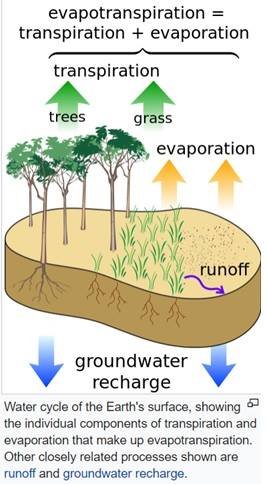)
Image Source
In doing so, the water goes through different forms:
- liquid,
- solid (or ice), and
- gaseous (or water vapor).
The water cycle involves the exchange of energy that leads to temperature changes. When water evaporates, it takes up energy from its surroundings and cools the environment. When it condenses, it releases energy and warms the environment. These heat exchanges influence climate.
The evaporative phase of the cycle purifies water which then replenishes the land with freshwater. The flow of liquid water and ice transports minerals across the globe. It is also involved in reshaping the geological features of the Earth, through processes including erosion and sedimentation.
The water cycle is also essential for the maintenance of most life and ecosystems on the planet.
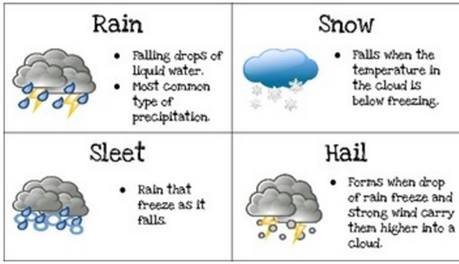)
Image Source
DESCRIPTION
The sun, which drives the water cycle, heats water in oceans and seas. Water evaporates as water vapor into the air. Ice and snow can sublimate directly into water vapor.
Evpotranspiration is water transpired from plants and evaporated from the soil. The water vapor molecule H2O has less density compared to the major components of the atmosphere, nitrogen and oxygen, N2 and O2.
Due to the significant difference in molecular mass, water vapor in gas form gains height in open air as a result of buoyancy. However, as altitude increases, air pressure decreases and the temperature drops.
The lowered temperature causes water vapor to condense into a tiny liquid water droplet which is heavier than the air, such that it falls unless supported by an updraft.
A huge concentration of these droplets over a large space up in the atmosphere becomes visible as clouds. Fog is formed if the water vapor condenses near ground level, as a result of moist air and cool air collision or an abrupt reduction in air pressure.
Air currents move water vapor around the globe, cloud particles collide, grow, and fall out of the upper atmospheric layers as precipitation.
Some precipitation falls as snow or hail, sleet, and can accumulate as ice caps and glaciers; which can store frozen water for thousands of years. Most water falls back into the oceans or onto land as rain, where the water flows over the ground as surface runoff.
A portion of runoff enters rivers in valleys in the landscape, with streamflow moving water towards the oceans. Runoff and water emerging from the ground (or groundwater) may be stored as freshwater in lakes.
Not all runoff flows into rivers, much of it soaks into the ground as infiltration. Some water infiltrates deep into the ground and replenishes aquifers, which can store freshwater for long periods of time.
Some infiltration stays close to the land surface and can seep back into surface-water bodies (and the ocean) as groundwater discharge. Some groundwater finds openings in the land surface and comes out as freshwater springs.
In river valleys and floodplains, there is often continuous water exchange between surface water and ground water in the hyporheic zone. Over time, the water returns to the ocean, to continue the water cycle.
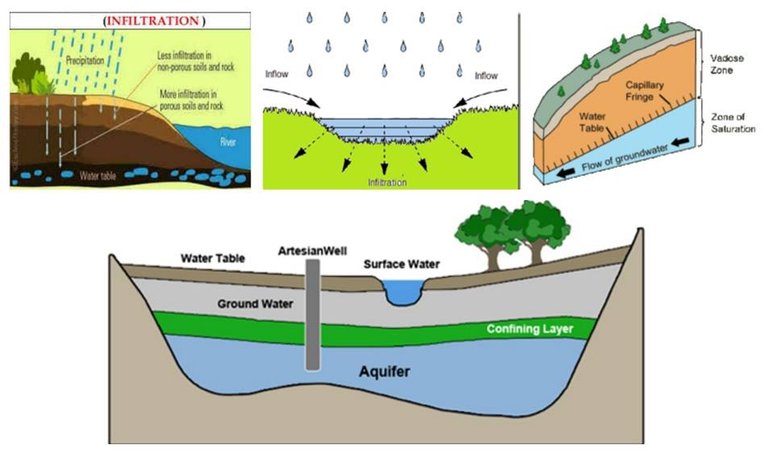)
Image Source
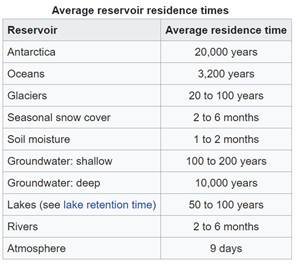)
Image Source
RESIDENCE TIMES
The “residence time” of a reservoir within the hydrologic cycle is the average time a water molecule will spend in that reservoir. It is a measure of the average age of the water in that reservoir.
Groundwater can spend over 10,000 years beneath Earth's surface before leaving. Particularly old groundwater is called “fossil water”.
Water stored in the soil remains there very briefly, because it is spread thinly across the Earth, and is readily lost by evaporation, transpiration, stream flow, or groundwater recharge.
After evaporating, the residence time in the atmosphere is about 9 days before condensing and falling to the Earth as precipitation.
The major ice sheets - Antarctica and Greenland - store ice for very long periods. Ice from Antarctica has been reliably dated to 800,000 years before present, though the average residence time is shorter.
In hydrology, residence times can be estimated in two ways. The more common method relies on the principle of “conservation of mass” and assumes the amount of water in a given reservoir is roughly constant.
With this method, residence times are estimated by dividing the volume of the reservoir by the rate by which water either enters or exits the reservoir.
Conceptually, this is equivalent to timing how long it would take the reservoir to become filled from empty if no water were to leave (or how long it would take the reservoir to empty from full if no water were to enter).
An alternative method to estimate residence times, which is gaining in popularity for dating groundwater, is the use of isotopic techniques. This is done in the subfield of isotope hydrology (uses isotopic dating to estimate the age and origins of water and of movement within the hydrologic cycle).
"Thank you reading my post"
follow upvote resteem @perjames
This makes me remember my high school days.
Great job @perjames
thank you my friend
Congratulations @perjames! You have received a personal award!
Click on the badge to view your Board of Honor.
Do not miss the last post from @steemitboard:
Congratulations @perjames! You received a personal award!
You can view your badges on your Steem Board and compare to others on the Steem Ranking
Do not miss the last post from @steemitboard:
Vote for @Steemitboard as a witness to get one more award and increased upvotes!